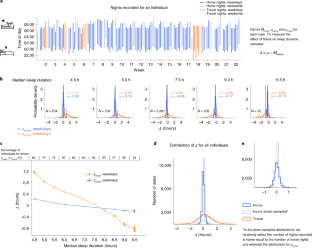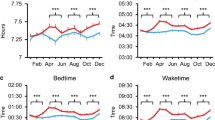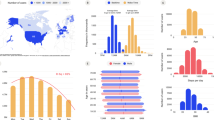Abstract
Travel is expected to have a deleterious effect on sleep, but an epidemiological-scale understanding of sleep changes associated with travel has been limited by a lack of large-scale data. Our global dataset of ~20,000 individuals and 3.17 million nights (~218,000 travel nights), while focused mainly on short, non-time-zone-crossing trips, reveals that travel has a balancing effect on sleep. Underslept individuals typically sleep more during travel than when at home, while individuals who average more than 7.5 hours of sleep at home typically sleep less when travelling. The difference in travel sleep quantity depends linearly on home sleep quantity and decreases as median sleep duration increases. On average, travel wake time advances to later hours on weekdays but earlier hours on weekends. Our study emphasizes the potential for consumer-grade wearable device data to explore how environment and behaviour affect sleep.
This is a preview of subscription content, access via your institution
Access options
Access Nature and 54 other Nature Portfolio journals
Get Nature+, our best-value online-access subscription
$29.99 / 30 days
cancel any time
Subscribe to this journal
Receive 12 digital issues and online access to articles
$119.00 per year
only $9.92 per issue
Buy this article
- Purchase on Springer Link
- Instant access to full article PDF
Prices may be subject to local taxes which are calculated during checkout



Similar content being viewed by others
Data availability
The raw data are not publicly available to preserve individuals’ privacy (according to the privacy policy for the wearable devices). Aggregated and anonymized data supporting the key findings in the paper are available from Figshare (https://doi.org/10.6084/m9.figshare.17207231); researchers interested in single-night data resolution may contact the corresponding authors regarding full data access.
Code availability
The code used to generate the results of this paper is available for download on GitHub (https://github.com/siggasvala/Travel-and-sleep).
References
Irwin, M. R. Why sleep is important for health: a psychoneuroimmunology perspective. Annu. Rev. Psychol. 66, 143–172 (2015).
Cappuccio, F. P., D’Elia, L., Strazzullo, P. & Miller, M. A. Sleep duration and all-cause mortality: a systematic review and meta-analysis of prospective studies. Sleep 33, 585–592 (2010).
Grandner, M. A. et al. Social and behavioral determinants of perceived insufficient sleep. Front. Neurol. 6, 112 (2015).
Luyster, F. S., Strollo, P. J., Zee, P. C. & Walsh, J. K. Sleep: a health imperative. Sleep 35, 727–734 (2012).
Cappuccio, F. P. et al. Meta-analysis of short sleep duration and obesity in children and adults. Sleep 31, 619–626 (2008).
King, C. R. et al. Short sleep duration and incident coronary artery calcification. JAMA 300, 2859–2866 (2008).
Cappuccio, F. P., Cooper, D., D’Elia, L., Strazzullo, P. & Miller, M. A. Sleep duration predicts cardiovascular outcomes: a systematic review and meta-analysis of prospective studies. Eur. Heart J. 32, 1484–1492 (2011).
Pilcher, J. J. & Huffcutt, A. I. Effects of sleep deprivation on performance: a meta-analysis. Sleep 19, 318–326 (1996).
Goldstein, A. N. & Walker, M. P. The role of sleep in emotional brain function. Annu. Rev. Clin. Psychol. 10, 679–708 (2014).
Bernert, R. A., Kim, J. S., Iwata, N. G. & Perlis, M. L. Sleep disturbances as an evidence-based suicide risk factor. Curr. Psychiatry Rep. 17, 15–24 (2015).
Ford, E. S., Cunningham, T. J. & Croft, J. B. Trends in self-reported sleep duration among US adults from 1985 to 2012. Sleep 38, 829–832 (2015).
Walker, M. P. A societal sleep prescription. Neuron 103, 559–562 (2019).
Czeisler, C. A. Perspective: casting light on sleep deficiency. Nature 497, S13 (2013).
Air Transport, Passengers Carried (World Bank, 2018); https://data.worldbank.org/indicator/IS.AIR.PSGR
Agnew, H. W., Webb, W. B. & Williams, R. L. The first night effect: an EEG study of sleep. Psychophysiology 2, 263–266 (1966).
Tamaki, M., Nittono, H., Hayashi, M. & Hori, T. Examination of the first-night effect during the sleep-onset period. Sleep 28, 195–202 (2005).
Tamaki, M., Bang, J. W., Watanabe, T. & Sasaki, Y. Night watch in one brain hemisphere during sleep associated with the first-night effect in humans. Curr. Biol. 26, 1190–1194 (2016).
Waterhouse, J., Reilly, T. & Edwards, B. The stress of travel. J. Sports Sci. 22, 946–966 (2004).
Reilly, T., Waterhouse, J. & Edwards, B. Jet lag and air travel: implications for performance. Clin. Sports Med. 24, 367–380 (2005).
Reilly, T., Waterhouse, J. & Edwards, B. Some chronobiological and physiological problems associated with long-distance journeys. Travel Med. Infect. Dis. 7, 88–101 (2009).
Lastella, M., Roach, G. D. & Sargent, C. Travel fatigue and sleep/wake behaviors of professional soccer players during international competition. Sleep Health 5, 141–147 (2019).
Waterhouse, J., Reilly, T., Atkinson, G. & Edwards, B. Jet lag: trends and coping strategies. Lancet 369, 1117–1129 (2007).
Srinivasan, V., Spence, D. W., Pandi-Perumal, S. R., Trakht, I. & Cardinali, D. P. Jet lag: therapeutic use of melatonin and possible application of melatonin analogs. Travel Med. Infect. Dis. 6, 17–28 (2008).
Morgenthaler, T. I. et al. Practice parameters for the clinical evaluation and treatment of circadian rhythm sleep disorders. Sleep 30, 1445–1459 (2007).
Wittmann, M., Dinich, J., Merrow, M. & Roenneberg, T. Social jetlag: misalignment of biological and social time. Chronobiol. Int. 23, 497–509 (2006).
Roenneberg, T., Allebrandt, K. V., Merrow, M. & Vetter, C. Social jetlag and obesity. Curr. Biol. 22, 939–943 (2012).
Ishibashi, Y. & Shimura, A. Association between work productivity and sleep health: a cross-sectional study in Japan. Sleep Health 6, 270–276 (2020).
Åkerstedt, T. et al. Sleep disturbances, work stress and work hours. J. Psychosom. Res. 53, 741–748 (2002).
Basner, M. et al. American time use survey: sleep time and its relationship to waking activities. Sleep 30, 1085–1095 (2007).
K. Pavlova, M. & Latreille, V. Sleep disorders. Am. J. Med. 132, 292–299 (2019).
Nédélec, M., Halson, S., Abaidia, A.-E., Ahmaidi, S. & Dupont, G. Stress, sleep and recovery in elite soccer: a critical review of the literature. Sports Med. 45, 1387–1400 (2015).
Fowler, P., Duffield, R. & Vaile, J. Effects of domestic air travel on technical and tactical performance and recovery in soccer. Int. J. Sports Physiol. 9, 378–386 (2014).
Forbes-Robertson, S. et al. Circadian disruption and remedial interventions. Sports Med. 42, 185–208 (2012).
Reilly, T. et al. Coping with jet-lag: a position statement for the European College of Sport Science. Eur. J. Sport Sci. 7, 1–7 (2007).
Fowler, P. M. et al. Greater effect of east versus west travel on jet lag, sleep, and team sport performance. Med. Sci. Sports Exerc. 49, 2548–2561 (2017).
Bourgeois-Bougrine, S., Carbon, P., Gounelle, C., Mollard, R. & Coblentz, A. Perceived fatigue for short- and long-haul flights: a survey of 739 airline pilots. Aviat. Space Environ. Med. 74, 1072–1077 (2003).
Sallinen, M. et al. Sleep, alertness and alertness management among commercial airline pilots on short-haul and long-haul flights. Accid. Anal. Prev. 98, 320–329 (2017).
Reis, C., Mestre, C., Canhão, H., Gradwell, D. & Paiva, T. Sleep complaints and fatigue of airline pilots. Sleep Sci. 9, 73–77 (2016).
Fowler, P., Duffield, R. & Vaile, J. Effects of simulated domestic and international air travel on sleep, performance, and recovery for team sports. Scand. J. Med. Sci. Sports 25, 441–451 (2014).
Richmond, L. K. et al. The effect of interstate travel on the sleep patterns and performance of elite Australian rules footballers. J. Sci. Med. Sport 10, 252–258 (2007).
McGuckin, T. A., Sinclair, W. H., Sealey, R. M. & Bowman, P. The effects of air travel on performance measures of elite Australian rugby league players. Eur. J. Sport Sci. 14, S116–S122 (2012).
Arendt, J. Managing jet lag: some of the problems and possible new solutions. Sleep Med. Rev. 13, 249–256 (2009).
Reilly, T., Atkinson, G. & Waterhouse, J. Travel fatigue and jet-lag. J. Sports Sci. 15, 365–369 (1997).
Borbély, A. A. A two process model of sleep regulation. Hum. Neurobiol. 1, 195–204 (1982).
Daan, S., Beersma, D. G. & Borbely, A. A. Timing of human sleep: recovery process gated by a circadian pacemaker. Am. J. Physiol. Regul. Integr. Comp. Physiol. 246, R161–R183 (1984).
Roenneberg, T. et al. Epidemiology of the human circadian clock. Sleep Med. Rev. 11, 429–438 (2007).
Luca, G. et al. Age and gender variations of sleep in subjects without sleep disorders. Ann. Med. 47, 482–491 (2015).
Kuula, L. et al. Using big data to explore worldwide trends in objective sleep in the transition to adulthood. Sleep Med. 62, 69–76 (2019).
Ong, J. L., Tandi, J., Patanaik, A., Lo, J. C. & Chee, M. W. L. Large-scale data from wearables reveal regional disparities in sleep patterns that persist across age and sex. Sci. Rep. 9, 3415 (2019).
Walch, O. J., Cochran, A. & Forger, D. B. A global quantification of “normal” sleep schedules using smartphone data. Sci. Adv. 2, e1501705 (2016).
Lo, J. C., Leong, R. L. F., Loh, K.-K., Dijk, D.-J. & Chee, M. W. L. Young adults’ sleep duration on work days: differences between east and west. Front. Neurol. 5, 81 (2014).
Jonasdottir, S. S., Minor, K. & Lehmann, S. Gender differences in nighttime sleep patterns and variability across the adult lifespan: a global-scale wearables study. Sleep https://doi.org/10.1093/sleep/zsaa169 (2020).
Hours Worked (Indicator) (Organisation for Economic Co-operation and Development, 2021); https://doi.org/10.1787/a452d2eb-en
Macridis, S., Johnston, N., Johnson, S. & Vallance, J. K. Consumer physical activity tracking device ownership and use among a population-based sample of adults. PLoS ONE 13, e0189298 (2018).
Depner, C. M. et al. Wearable technologies for developing sleep and circadian biomarkers: a summary of workshop discussions. Sleep 43, zsz254 (2019).
Silva, M.-R. G., Pascoal, A., Silva, H.-H. & Paiva, T. Assessing sleep, travelling habits and jet lag in kite surfers according to competition level. Biol. Rhythm Res. 47, 677–689 (2016).
Girschik, J., Fritschi, L., Heyworth, J. & Waters, F. Validation of self-reported sleep against actigraphy. J. Epidemiol. 22, 462–468 (2012).
Ancoli-Israel, S. et al. The role of actigraphy in the study of sleep and circadian rhythms. Sleep 26, 342–392 (2003).
Althoff, T., Horvitz, E., White, R. W. & Zeitzer, J. Harnessing the web for population-scale physiological sensing. In Proc. 26th International Conference on World Wide Web 113–122 (International World Wide Web Conferences Steering Committee, 2017); https://doi.org/10.1145/3038912.3052637
Doherty, A. et al. Large scale population assessment of physical activity using wrist worn accelerometers: the UK Biobank study. PLoS ONE 12, e0169649 (2017).
Winnebeck, E. C., Fischer, D., Leise, T. & Roenneberg, T. Dynamics and ultradian structure of human sleep in real life. Curr. Biol. 28, 49–59.e5 (2018).
Palotti, J. et al. Benchmark on a large cohort for sleep–wake classification with machine learning techniques. NPJ Digit. Med. 2, 50 (2019).
Aslak, U. & Alessandretti, L. Infostop: scalable stop-location detection in multi-user mobility data. Preprint at https://arxiv.org/abs/2003.14370 (2020).
Faraway, J. J. Extending the Linear Model with R (Chapman and Hall/CRC, 2016); https://doi.org/10.1201/9781315382722
R Core Team. R: A Language and Environment for Statistical Computing (R Foundation for Statistical Computing, 2018); https://www.R-project.org/
Kuznetsova, A., Brockhoff, P. B. & Christensen, R. H. B. lmertest package: tests in linear mixed effects models. J. Stat. Soft. https://doi.org/10.18637/jss.v082.i13 (2017).
Luke, S. G. Evaluating significance in linear mixed-effects models in R. Behav. Res. 49, 1494–1502 (2016).
Acknowledgements
S.L. thanks the DISTRACT project (European Research Council) and the Nation-Scale Social Networks Project (Villum Foundation) for support of this work. J.B. acknowledges support from Google Open Source under the Open-Source Complex Ecosystems and Networks (OCEAN) project. The funders had no role in study design, data collection and analysis, decision to publish or preparation of the manuscript.
Author information
Authors and Affiliations
Contributions
S.S.J., S.L. and J.B. designed the research. S.S.J. preprocessed the data, performed the data analysis and created the figures. S.S.J., S.L. and J.B. analysed the results and wrote the paper.
Corresponding author
Ethics declarations
Competing interests
The authors declare no competing interests.
Peer review
Peer review information
Nature Human Behaviour thanks Shahab Haghayegh, Eva Winnebeck and the other, anonymous, reviewer(s) for their contribution to the peer review of this work. Peer reviewer reports are available.
Additional information
Publisher’s note Springer Nature remains neutral with regard to jurisdictional claims in published maps and institutional affiliations.
Supplementary information
Supplementary Information
Supplementary Figs. 1–14, Tables 1–20, Methods and Discussion.
Rights and permissions
About this article
Cite this article
Jonasdottir, S.S., Bagrow, J. & Lehmann, S. Sleep during travel balances individual sleep needs. Nat Hum Behav 6, 691–699 (2022). https://doi.org/10.1038/s41562-022-01291-0
Received:
Accepted:
Published:
Issue Date:
DOI: https://doi.org/10.1038/s41562-022-01291-0



